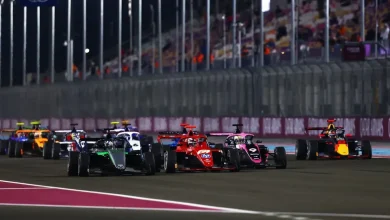Is the US still a growth market? Five things we learned at the F1 Business Summit

In just three years, the Las Vegas Grand Prix has become a hub of commercial activity for Formula One.
Both the series and its teams leverage the event to make new or extended sponsorship announcements, while several brands lean into the city’s reputation as an entertainment destination by running creative activations around the race. There are also plenty of premium hospitality experiences for what has become one of the most anticipated Grands Prix on the calendar.
With that in mind, it is perhaps fitting that the desert city was the host of the inaugural F1 Business Summit, which was staged in partnership with series owner Liberty Media and the CAA agency.
The event offered a broad overview of the series’ ongoing commercial growth, covered the technological innovations that will influence the sport in the future, and even featured comment from the wider sports and entertainment world.
Speakers included Formula One president and chief executive Stefano Domenicali and Liberty Media president and chief executive Derek Chang, as well as figures from some of the series’ commercial partners, including Fanatics, T-Mobile, Lego and American Express.
After sitting in on the panels at Wynn Las Vegas, BlackBook Motorsport picks out some of the key takeaways from Formula One’s landmark debut business event.
The inaugural F1 Business Summit took place during race week in Las Vegas (Image credit: Formula One)
1. The US remains “a huge potential market” – not a mature one
Formula One has placed a huge emphasis on growing in the US during the Liberty era. The Las Vegas Grand Prix is now one of three races in the country and the series has reached an all-time high in US partnerships, according to recent analysis from Spomotion Analytics. The championship also claims that it now has an American fanbase of 52 million.
Despite these landmarks, Liberty still views the country as a growth opportunity for the series. Indeed, Chang described the US as “a huge potential market” for Formula One and “not a mature market” yet.
From next season, Formula One will be aired exclusively in the US on streaming platform Apple in a deal worth around US$150 million a season – or US$750 million over the lifetime of the contract. Chang sees this as a “game changer” for the series in the US, with the new broadcast arrangement set to change the way Formula One is consumed in the country.
Domenicali, meanwhile, believes that the current schedule of US races provides a good foundation for growth. Indeed, the 2025 Global F1 Fan Survey revealed that 73 per cent of fans in the country plan to attend a race in the future.
“We are here to stay, we are here to grow, we are here to be socially relevant for this incredible market that is not only business, it’s something bigger,” Domenicali said. “That is why Las Vegas, Miami, Austin is a perfect combination in this incredible country.”
The Formula One paddock receives a locally inspired makeover in Vegas (Image credit: Getty Images)
2. Licensing has been “an untapped category”
It could be argued that Formula One has been behind on licensing opportunities in the past, but that has changed under the commercial leadership of Emily Prazer. To that end, recent years have seen the championship enter licensing collaborations with Lego, Disney and Hot Wheels manufacturer Mattel.
Formula One chief commercial officer Prazer, who also serves as the president of the Las Vegas Grand Prix, acknowledged during her panel that licensing has been “an untapped category” for Formula One, but has become a crucial part of the series’ fan engagement strategy as it seeks to connect with viewers beyond just the 24 races – especially new fans converted by Drive to Survive.
“Working with the likes of Disney and Lego, it’s given us a lot of new knowledge about how to engage with that consumer – as an organisation we haven’t done it prior,” she explained.
“We are very humble about the fact that we’ve had to learn, we’re very grateful to our partners for giving us the time to teach us because it has taken a minute for us to pivot and understand how to do it.”
One longstanding partner in the licensing space is merchandise giant Fanatics, which brought Ferrari driver and athlete partner Lewis Hamilton to the opening of its collectibles store in London in April.
Fanatics founder and chief executive Michael Rubin revealed that the store was expected to generate US$5 million in its debut year, but is now anticipated to deliver US$25 million in revenue in year one.
“F1 has been an incredible partnership,” Rubin said. “We only got in business with F1 probably six or seven years ago, it’s now a meaningful nine-figure business. We see our best customers [from F1] too. We love to activate with F1 because the most valuable Fanatics customers are F1 customers.”
To underline this positive momentum, Formula One looks set to break records in Las Vegas for all its merchandise, according to Chang.
3. Structuring the calendar continues to be a challenge
One challenge for Formula One’s global aspirations is the finite number of slots on the calendar. With half the races in Europe and long-term contracts agreed with the majority of promoters, it’s difficult to see where there is room to expand into new territories.
However, that doesn’t mean the series isn’t constantly evaluating new opportunities.
“You’re not going to be everywhere, but if you’re in enough different geographical locations like Singapore…that brings in a lot of people from Southeast Asia who can access the race because they’re within two hours of Singapore,” said Chang.
In terms of new opportunities, Chang described India as “hugely interesting” but noted that it’s “not an easy place to do business”.
Ultimately, the list of interested countries is likely to far outweigh the number of available spots as long as Formula One retains its current level of popularity.
That said, Chang added that there are still “certain geographies” that Formula One isn’t maximising to their full potential. However, this is likely to remain a challenge as long as the series operates with its current 24-race schedule with three-day weekends.
The Las Vegas Grand Prix is one of three Formula One races in the US, with the current contract in place until the end of the 2027 season (Image credit: Getty Images)
4. Success is when you don’t see gender in sport
F1 Academy is benefitting from significant visibility as the only support category at the Las Vegas Grand Prix, and the F1 Business Summit included a discussion on the continued progress of women’s sport.
For Julie Uhrman, president and co-founder of Angel City, a team in the National Women’s Soccer League (NWSL), success in the area of diversity “is when you don’t see gender in sport”.
While acknowledging the progress that has already been achieved, Uhrman highlighted that there is still a way to go before true equity is achieved.
“Deloitte came out and said that women’s sport is going to be worth US$2.5 billion this year, a pretty incredible number – until you think about men’s sport: US$471 billion,” she said.
“And I only say that by comparison because our trajectory is much steeper right now than men’s sports…we’re past talking about it being a moment, it’s about a movement, we’re trying to keep up with it right now.”
In terms of how this applies to the world of Formula One and wider sport, F1 Academy is breaking down barriers to entry on the track, but Rubin suggested there is still some work to be done to cater to a rapidly growing female fanbase.
“In the sports merchandise business, it’s about 50/50 of who buys it, but it’s actually about 75 per cent male-oriented, it’s about 13, 14 per cent female-oriented, and about 11 or 12 per cent kids,” Rubin revealed. “The reason is I think we haven’t done a good enough job making great women’s products, great kids’ products.”
Susie Wolff, managing director of F1 Academy, moderated a panel looking at the key contributors to the rise in popularity of women’s sport (Image credit: Formula One)
5. Cloud-based twins could unlock the next level of F1 development
As Formula One looks to the future, there is no doubt that technology will continue to evolve the product on the track.
John Saw, the president of technology and chief technology officer at T-Mobile, which this week expanded its relationship with Formula One to become its regional 5G innovation partner, pinpointed what he believes is going to have a major impact on the sport in the years ahead.
“I think the next major disruptor for F1 is going to be a greater use of cloud-based twins to build an exact replica of Formula One cars, and to build digital twins of all Formula One racetracks,” he said.
The barrier to adopting the technology is any future regulations that the International Automobile Federation (FIA) may decide to introduce around it. Even so, having accurate recreations of each circuit’s characteristics and the impact of real-world conditions on the cars would undoubtedly improve each team’s simulation capabilities.
Saw added: “What if we have AI agents that are in touch with…the drag and temperatures and aerodynamics, and when we come to race weekends while you are doing your practice runs, they can train and finetune their digital twins so that they can make recommendations looking at the weather and the temperature on what the tyre strategy and race strategy is. It’s like a co-pilot for a race engineer.”





